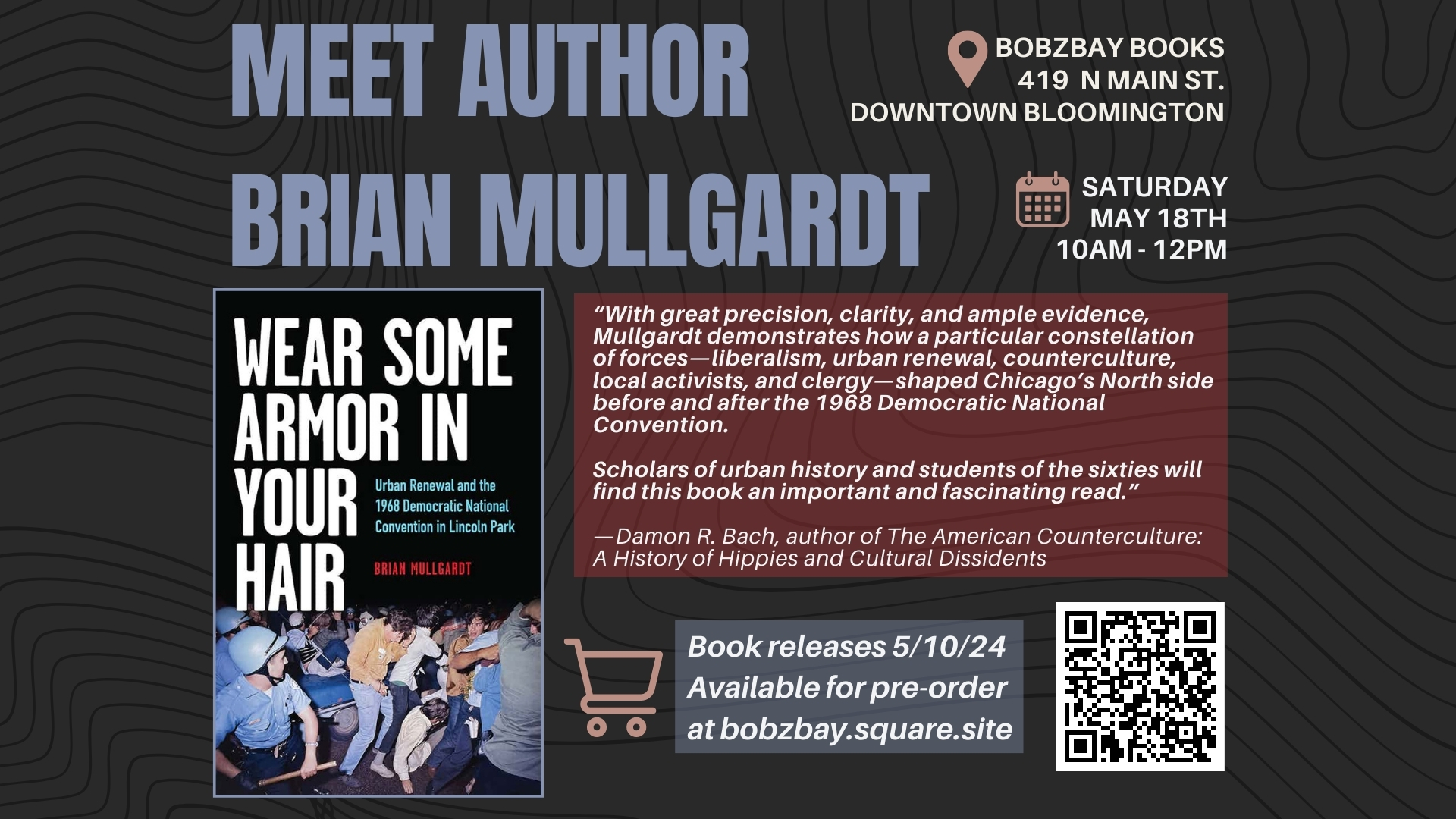
Book Signing with Non-Fiction Author Brian Mullgardt at Bobzbay Books
A limited number of books will be available at the signing but pre-orders are highly encouraged! Pre-order your book here: https://bobzbay.square.site/product/WearSomeArmor/11009
About the book:
Police brutality, gentrification, and grassroots activism in 1960s Chicago
In August of 1968, approximately 7,000 people protested the Vietnam War against the backdrop of the Democratic National Convention in Chicago. This highly televised event began peacefully but quickly turned into what was later termed a “police riot.” Brian Mullgardt’s investigation of this event and the preceding tensions shines a light on the ministers, Yippies, and community members who showed up and stood together against the brutality of the police. Charting a complex social history, Wear Some Armor in Your Hair brings together Chicago history, the 1960s, and urbanization, focusing not on the national leaders, but on the grassroots activists of the time.
Beginning in 1955, two competing visions of urban renewal existed, and the groups that propounded each clashed publicly, but peacefully. One group, linked to city hall, envisioned a future Lincoln Park that paid lip service to diversity but actually included very little. The other group, the North Side Cooperative Ministry, offered a different vision of Lincoln Park that was much more diverse in terms of class and race. When the Yippies announced anti-war protests for the summer of ‘68, the North Side Cooperative Ministry played an instrumental role. Ultimately, the violence of that week altered community relations and the forces of gentrification won out.
Mullgardt’s focus on the activists and community members of Lincoln Park, a neighborhood at the nexus of national trends, broadens the scope of understanding around a pivotal and monumental chapter of our history. The story of Lincoln Park, Chicago, is in many ways the story of 1960s activism writ small, and in other ways challenges us to view national trends differently.
About the Author:
Brian Mullgardt is a professor of history at Millikin University who specializes in US history in the Cold War era, with an emphasis on social activism during the “Long Sixties” (1955-1975). He has served as the vice president of the Macon County Historical Society and Museum and on the board of directors for the Illinois State Historical Society. He has published in several journals, including the Journal of the Illinois State Historical Society and the Journal of Illinois History.
Favorable reviews:
“With great precision, clarity, and ample evidence, Mullgardt demonstrates how a particular constellation of forces—liberalism, urban renewal, counterculture, local activists, and clergy—shaped Chicago’s North side before and after the 1968 Democratic National Convention. Scholars of urban history and students of the sixties will find this book an important and fascinating read.”—Damon R. Bach, author of The American Counterculture: A History of Hippies and Cultural Dissidents
“Views of the 1960s counterculture are too often simplified and centered on the coasts, with images of dancing flower children and rebellious youth. Mullgardt offers a valuable corrective, focusing not on the leaders of the protests, but on local Chicago activists, including clergy and people of color. The Yippies who came to Chicago found that there was already a movement for equality and justice happening here—and it continued after the DNC circus left town.”—Mary Wisniewski, author of Algren: A Life
“This is an ambitious work that weaves several heretofore separate stories into a new account of both Lincoln Park and the 1968 Democratic Convention. In doing so, Mullgardt adds to our understanding of both urban renewal and gentrification, as well as to their fascinating connections to 1960s counterculture and radical politics. Through the lens of the Lincoln Park neighborhood in 1960s, the book explores larger issues including civil rights, the counterculture, and radical politics that played out during the Democratic Convention in August 1968. In doing so, it offers a nuanced and grounded view of national events, as well as showing the ways that Lincoln Park leaders, issues, and organizations shaped broader events. The real power of this book is that it does not stay in one academic lane, but pulls threads from multiple fields to tell the story of gentrifying Lincoln Park and the 1968 Convention.”—Ann Durkin Keating, coeditor, Encyclopedia of Chicago
